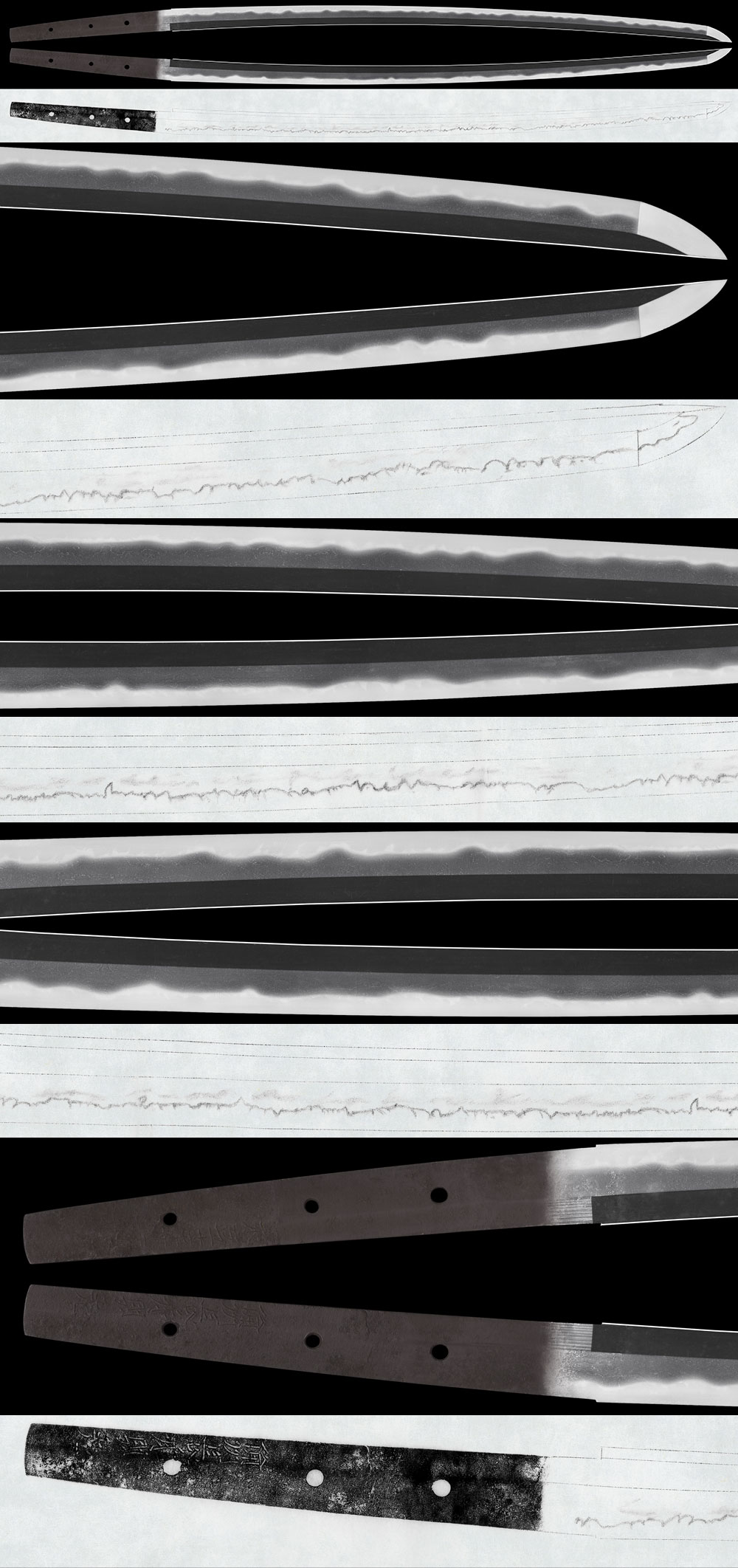Description
Dai Sho :
———————
Dai : Katana in Shirasaya with Koshirae
Katana: Katana in Shirasaya with Koshirae (NBTHK Tokubetsu Hozon Token)
Signature: Bishu Osafune Norimitsu (4th generation)
Dated: Eikyo 11, 2nd month (1441)
備州長船則光(4代)
永享十一年二月日
Chu-Koto: Jyojyo Saku: Ryo-Wazamono: Bizen
We divide 4 sections for each sword as Saijyo Saku, Jyojyo Saku, Jyo Saku and Regular Saku.
This piece is ranked as Jyojyo Saku among works by Bishu Osafune Norimitsu.
Daimyo Registration
Registration Number: Osaka No. 5084
Date of Issue: June 28, 1951
Habaki: Single gold-covered
Blade Length: 2 shaku 4 sun 7 bu 5 rin (74.99 cm / 29.52 in)
Curvature: 5 bu (1.51 cm / 0.59 in)
Mekugi Hole: 3
Width at Base (Motohaba): 3.14 cm (1.24 in)
Width at Tip: 1.97 cm (0.78 in)
Thickness of rim (Kasane): 0.74 cm (0.29 in)
Sword Weight: 900 g
Era: Muromachi period, Eikyo 11 (1441)
Shape: There is a ~5 cm suriage, but the signature and date remain completely intact.
The blade has a wide mihaba, solid kasane, deep curvature, and a long extended kissaki.
Jigane: Well-forged shinogi-ji with tightly packed ko-itame hada and mokume, showing antique character.
Itame hada mixed with masame, with visible utsuri.
Hamon: Choji-midare in nioi-deki with slightly compact pattern.
Ashi is active and boshi is midare-komi.
Features:
The 1st generation is said to be a student of the famous Nagamitsu and son of Toshimitsu.
The 4th generation, who made this blade, is Norimitsu of Eikyo Bizen, son of Sukememon.
Unlike the kamakura to Nanbokucho period, the hamon shows a flamboyant choji-midare typical of later Bizen work.
He is known to have produced works from the Oei to Bunmei periods.
Koshirae:
Tsuba: Shakudo nanako ground with high-relief carvings of paulownia and family crests, decorated with gold.
Fuchikashira: Shakudo nanako ground with high-relief peonies and flying butterflies, decorated with gold.
Saya (Scabbard): Black lacquered saya
Menuki: Shakudo with high-relief flying wild geese design, decorated with gold.
———————
Sho : Wakizashi in Shirasaya with Koshirae (NBTHK Hozon Token)
Signature: Mumei (attributed to Hamabe)
無銘(浜部)
Shinshinto: Jyo Saku: Bizen
We divide 4 sections for each sword as Saijyo Saku, Jyojyo Saku, Jyo Saku and Regular Saku.
This piece is ranked as Jyo Saku among works attributed to Mumei (Hamabe).
Daimyo Registration
Registration Number: Nara No. 2362
Date of Issue: May 17, 1951
Habaki: Single gold-covered
Blade Length: 46.3 cm (18.23 in)
Curvature: 1.2 cm (0.47 in)
Mekugi Hole: 1
Width at Base (Motohaba): 2.64 cm (1.04 in)
Width at Tip: 1.79 cm (0.70 in)
Thickness of rim (Kasane): 0.58 cm (0.23 in)
Sword Weight: 395 g
Era: Edo period, around Tenmei era
Shape: Standard mihaba and original nakago.
Standard length with an extended kissaki.
Jigane: Tightly forged ko-itame hada with ji-nie, forming a beautiful texture.
Hamon: Nie-deki with gunome-midare close to nioi-deki.
Yahazu-shaped pattern with rich variety.
Koshirae:
Tsuba: Shakudo nanako ground with high-relief carvings of paulownia and family crests, decorated with gold.
Fuchikashira: Shakudo nanako ground with high-relief peonies and flying butterflies, decorated with gold.
Saya (Scabbard): Black lacquered saya
Menuki: Shakudo with high-relief flying wild geese design, decorated with gold.
Kozuka/Small Knife: Small knife signed “Chiyozuru” with gunome-midare hamon.
Features:
The Hamabe school represents the Shinshinto period smiths of Inaba (Tottori).
Descendants of Mino swordsmiths, they moved to Okayama in the late Muromachi period,
later settling in Inaba and flourishing through the Bakumatsu period.
———————
Aoi Art’s Comment:
This Daisho set has a commanding presence and both swords are registered as Daimyo property.
Matched Daisho koshirae are rare and highly recommended.
Certificates:
Tokubetsu Hozon Token (Dai)
Hozon Token (Sho)
Aoi Art estimation paper: Whole Oshigata










 日本語
日本語







